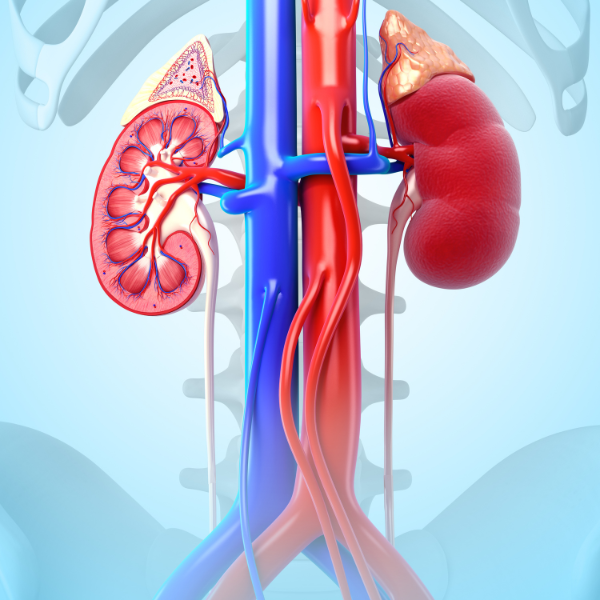
Chronic kidney disease affects an estimated 40% of people with diabetes in the United Kingdom. Here’s how to prevent and manage kidney disease in diabetes.
According to recent statistics, almost 800,000 people in the United States have chronic kidney disease, with diabetes causing 47% of cases.1
In the United Kingdom, 3.6 million people have diabetes, and approximately 42.3% of those with type 2 and 32.4% with type 1 diabetes have signs of kidney damage.2 Evidence suggests that 18-30% of these individuals develop advanced kidney disease, which can progress to kidney failure if undetected.3
If you have diabetes, you can prevent chronic kidney disease or its progression to kidney failure by monitoring your kidney function, managing your blood sugar, improving your diet, and controlling your blood pressure, blood fats and weight.
This post discusses how diabetes-related kidney disease develops and tips to prevent and manage it.
The role of the kidney
The kidneys are the bean-shaped organs on either side of the spine, at the lower back. They are responsible for many complex and essential roles that keep the rest of the body functioning correctly. Some of their functions include:4
- Removing waste products and excess fluid
- Filtering the blood
- Controlling the production of red blood cells
- Producing hormones that control blood pressure, blood volume and bone health
What is chronic kidney disease?
Chronic kidney disease (CKD) is a progressive condition resulting from changes in the kidney’s structure and a gradual loss of its function.5 It can cause anaemia, waste build-up, nerve damage, and weak bones. CKD can also raise the risk of heart disease and stroke, and if it keeps getting worse, it can lead to kidney failure.5
Persistent high blood sugar is the crucial reason CKD develops in people with diabetes.6 High blood sugar causes the vessels carrying blood into the kidneys (afferent arterioles) to widen and those taking blood away from the kidneys (efferent arterioles) to shrink, increasing blood pressure within the kidneys and making them leaky.6

High blood sugar also causes the formation of compounds called advanced glycosylated end products or AGEs and the activation of a protein called protein kinase C, which also increases kidney blood pressure and makes them leaky.6 Moreover, AGEs activate inflammatory proteins and free radicals that cause inflammation and damage the kidneys further.6,7
How chronic kidney disease is detected
Doctors detect kidney disease by performing blood and urine tests.
Blood tests assess kidney function by measuring creatinine (a waste product), which alongside age, gender and ethnicity, is used to calculate the glomerular filtration rate (GFR). Urine tests check for albumin – a protein that should not be present in urine – by measuring the albumin-to-creatine ratio (ACR).
The eGFR declines with age, but the average healthy person has an eGFR of at least 90mL/min/1.73m2 and urine albumin of less than 30 mg/g or 3 mg/mmol.2,8
An individual has kidney disease if, after three separate tests over 90 days, at least two shows:9,10,11
- An eGFR is of less than 60mL/min/1.73 and/or
- An ACR above 3mg/mmol [30 mg/g]
Factors increasing the risk of kidney disease
Besides diabetes, high blood pressure and obesity, many other factors increase the risk of CKD, including: 3,12
- having a family history of kidney failure,
- older age
- ethnicity
- heart disease
- Frequent use of medications and herbal remedies that damage the kidneys
- smoking
Compared with Caucasians, African Americans, American Indians, Hispanics and Pacific Islanders have a significantly greater risk of kidney disease, partly due to the higher rates of high blood pressure and obesity.1,3,13
Symptoms of chronic kidney disease
Many people with diabetic kidney disease have no symptoms and are usually identified during routine screening for diabetes care. Individuals identified late could have any one of these symptoms:12
- Lethargy/pallor
- Difficulty concentrating
- Poor appetite
- Difficulty sleeping
- Muscle cramping, especially at night
- Dry, itchy skin
- Needing to urinate more often, particularly at night
- Puffiness around the eyes
- Swollen feet and ankles
- Weak bones and increased risk of bone fractures
How to prevent and manage chronic kidney disease in diabetes
1 | Reach and maintain your blood sugar target
Since high blood sugar is the driving factor for chronic kidney disease in diabetes, reaching and maintaining your blood sugar target can significantly reduce your risk of developing it or preserving your kidney function if you already have it.
Your blood sugar target depends on many factors, including age, how long you have had diabetes, the types of medication you take and if you have other co-existing conditions.9 Your healthcare team will set an appropriate target for you.
If you have type 2 diabetes, they may also recommend sodium-glucose co-transporter 2 inhibitors (SGLT2i) – a blood-sugar lowering drug that preserves kidney function.9,10,11

2 | Control your blood pressure
High blood pressure is another crucial risk factor for kidney disease, which also increases heart disease risk. International guidelines recommend keeping your blood pressure below 140/90 mm/Hg and, in some cases, below 130/80 mm/Hg.9,10,11
Your doctor will likely recommend blood pressure-lowering drugs such as angiotensin-converting enzyme inhibitors (ACEi) or angiotensin-receptor blockers (ARBs).9,10,11
3 | Reach and maintain your blood fats
People with diabetic kidney disease typically have low high-density lipoprotein (HDL) or ‘good’ cholesterol levels, with high triglycerides and low-density lipoprotein (LDL) or ‘bad’ cholesterol. This blood fat profile worsens kidney function and increases the risk of heart disease.12
Your doctor may recommend a statin – a cholesterol-lowering medication.9,10,11
4 | Maintain a healthy weight
Researchers have found a strong link between obesity and diabetic kidney disease. Although the pathways involved are unknown, scientists suggest obesity damages the blood vessels in the kidney and make them leaky.12 Weight loss can improve cardiovascular health, potentially slow kidney function decline and reduce protein leakage in urine.5
5 | Eat a healthy diet
Besides controlling your weight, a healthy diet can improve your blood pressure and blood fats and lower your blood sugar. A low glycaemic diet, a low carb diet, the Mediterranean diet, and the Dietary Approaches to Stop Hypertension (DASH) diet are some clinically proven diets to help with weight loss, blood pressure and blood sugar control.14
It is crucial to choose a healthy eating pattern that you can sustain because yo-yo dieting can encourage weight gain and worsen blood sugar control. If you need support, work with a registered dietitian or nutritionist specialising in diabetes care to create a healthy eating plan tailored to your needs.
6 | Reduce your salt intake
High sodium intake raises blood pressure and increases the risk of stroke, heart disease and overall mortality.10 Data from studies in the general population show that reducing sodium intake alone or by eating a low-salt diet, such as the DASH diet, lowers blood pressure.10
Kidney Internal Global Outcomes (KDIGO) guidelines recommend limiting sodium intake to less than 2.3 g (or 6g of salt) daily.10
7 | Perform moderate exercise regularly
Exercise improves insulin sensitivity, heart health, HDL cholesterol, and overall well-being.5,10 KDIGO guidelines recommend that people with diabetes and CKD undertake moderate exercise for at least 150 minutes per week.10
Moderate exercise includes brisk walking, cycling, yoga or swimming.5
8 | Quit smoking
Smoking independently increases the risk of developing kidney disease and its progression to kidney failure.12 It does this by increasing inflammation, raising LDL cholesterol, increasing the production of AGEs and directly damaging kidney blood vessels.12 A study in people with type 1 diabetes found that smokers had a higher risk of kidney disease than non-smokers.15
The National Health Service (NHS) in England offers resources to help you quit smoking.
9 | Monitor your kidneys
Regular monitoring will help your doctors identify changes to your kidney function and start appropriate treatment promptly.9,10,11
Guidelines recommend checking your kidney function annually if you have type 2 diabetes or have had type 1 diabetes for more than ten years. You may need more frequent monitoring (every three to six months) if you have established kidney disease.9,11

Although long-standing diabetes increases the risk of kidney disease, not everyone with diabetes will develop it.
You can prevent it by implementing the steps shared in this post. If you already have kidney disease, implementing these steps can help preserve your kidney function or slow the progression to advanced kidney disease.
Making lifestyle changes, i.e., improving your diet and exercising regularly, is the first and best thing you can do for your kidneys. Please get support if you’ve tried without success or don’t know how to start.
REFERENCES
- Burrows, N.R., Koyama, A., & Pavkov, M.E. (2022) Reported cases of end-stage kidney disease – United States, 2000-2019. Morbidity and Mortality Weekly Report, 71(11): 412–415.
- Zac-Varghese, S., & Winocour, P. (2017) Managing diabetic kidney disease. British Medical Bulletin, 125(1): 55–66.
- Chen, T.K., Knicely, D.H., & Grams, M.E. (2019) Chronic kidney disease diagnosis and management. JAMA, 322(13): 1294–1304.
- Ogobuiro, I., & Tuma, F. (2022) Physiology, Renal. Available: https://www.ncbi.nlm.nih.gov/books/NBK538339/. Accessed: 04 November 2022.
- Kalantar-Zadeh, K., Jafar, T.H., Nitsch, D., Neuen, B.L., & Perkovic, V. (2021) Chronic kidney disease. Lancet, 398 (10302): 786-802.
- Schena, F.P., & Gesualdo, L. (2005) Pathogenetic mechanisms of diabetic nephropathy. Journal of the American Society of Nephrology, 16: S30-S33.
- Toth-Manikowski, S., & Atta, M.G. (2015) Diabetic kidney disease: pathophysiology and therapeutic targets. Journal of Diabetes Research, htts://dio.org/10.1155/2015/697010.
- Delanaye, P., Schaeffner, E., Ebert, N., Cavalier, E., Mariat, C., Krzesinski, J-M., Moranne, O. (2012) Normal reference values for glomerular filtration rate: what do we really know? Nephrology Dialysis Transplantation, 27(7): 2664-2672.
- American Diabetes Association (2022). Chronic kidney disease and risk management: standards of medical care in diabetes – 2022. Diabetes Care, 45 (Suppl. 1): S175-S184
- Kidney Disease Improving Global Outcomes (KDIGO). (2020) Clinical practice guidelines for diabetes management in chronic kidney disease. Kidney International, 98: S1-S115.
- National Institute for Health and Care Excellence (2021). Chronic kidney disease: assessment and management. Available: https://www.nice.org.uk/guidance/ng203 Accessed: 04 November 2022
- Hussain, S., Jamali, M.C., Habib, A., Hussain, M.S., Akhtar, M., & Najmi, A.K. (2020) Diabetic kidney disease: an overview of prevalence, risk factors, and biomarkers. Clinical Epidemiology and Global Health, 9: 2-6.
- Tuttle, K.R., Jones, C.R., Daratha, K.B., Koyama, A.K., Nicholas, S.B., Alicic, R.Z., Duru, O.K., Neumiller, J.J., Norris, K.C., Burrows, N.R. Pavokv, M.E. (2022) Incidence of chronic kidney disease among adults with diabetes, 2015-2020. New England Journal of Medicine, 387: 1430–1431.
- Cicero, A.F.G., Veronesi, M., & Fogacci, F. (2021) Dietary intervention to improve blood pressure control: beyond salt restriction. High Blood Pressure & Cardiovascular Prevention, 28(6): 547-553.
- Feodoroff, M., Harjutsalo, V., Forsblom, C., Thorn, L., Waden, J., Tolonen, N., Lithovius, R., Groop, P-H. (2016) Smoking and progression of diabetic nephropathy in patients with type 1 diabetes. Acta Diabetologica, 53: 525-533.
- American Diabetes Association. (2021) Microvascular complications and foot care: standards of medical care in diabetes – 2021. Diabetes Care, 44(Supplement 1): S151-S167
DISCLAIMER: Not a substitute for medical advice – All content is for informational purposes only and is not intended to provide medical or nutrition advice or to take the place of medical/nutrition advice or treatment from your doctor or health professional. Since each person’s health conditions are very specific, viewers of this content are advised to consult their doctors or qualified health professionals regarding specific health questions. All content, including text, graphics, images, and information in this post/video, is for general information only and does not replace a consultation with your doctor/health professional.

